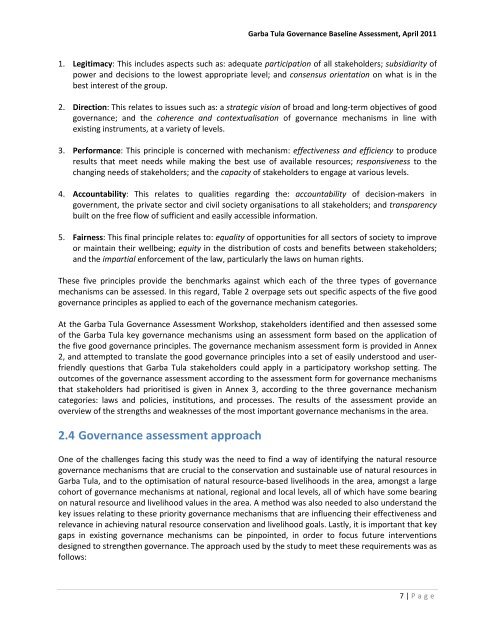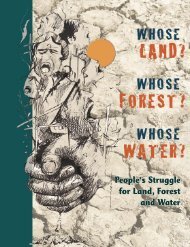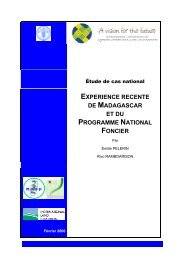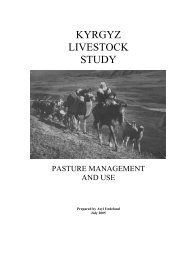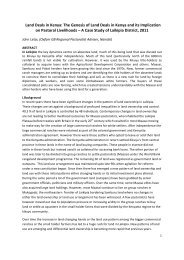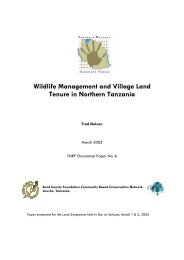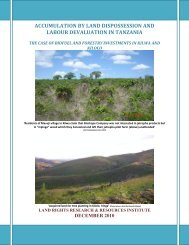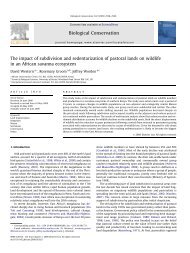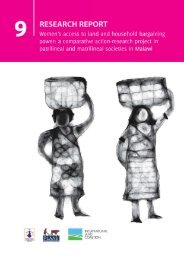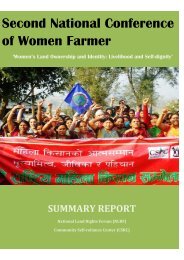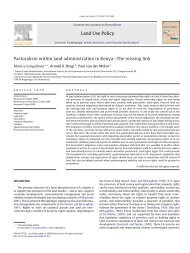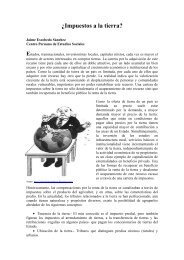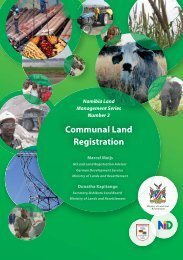Garba Tula Governance Assessment Final Report ... - Land Portal
Garba Tula Governance Assessment Final Report ... - Land Portal
Garba Tula Governance Assessment Final Report ... - Land Portal
You also want an ePaper? Increase the reach of your titles
YUMPU automatically turns print PDFs into web optimized ePapers that Google loves.
<strong>Garba</strong> <strong>Tula</strong> <strong>Governance</strong> Baseline <strong>Assessment</strong>, April 2011<br />
1. Legitimacy: This includes aspects such as: adequate participation of all stakeholders; subsidiarity of<br />
power and decisions to the lowest appropriate level; and consensus orientation on what is in the<br />
best interest of the group.<br />
2. Direction: This relates to issues such as: a strategic vision of broad and long-term objectives of good<br />
governance; and the coherence and contextualisation of governance mechanisms in line with<br />
existing instruments, at a variety of levels.<br />
3. Performance: This principle is concerned with mechanism: effectiveness and efficiency to produce<br />
results that meet needs while making the best use of available resources; responsiveness to the<br />
changing needs of stakeholders; and the capacity of stakeholders to engage at various levels.<br />
4. Accountability: This relates to qualities regarding the: accountability of decision-makers in<br />
government, the private sector and civil society organisations to all stakeholders; and transparency<br />
built on the free flow of sufficient and easily accessible information.<br />
5. Fairness: This final principle relates to: equality of opportunities for all sectors of society to improve<br />
or maintain their wellbeing; equity in the distribution of costs and benefits between stakeholders;<br />
and the impartial enforcement of the law, particularly the laws on human rights.<br />
These five principles provide the benchmarks against which each of the three types of governance<br />
mechanisms can be assessed. In this regard, Table 2 overpage sets out specific aspects of the five good<br />
governance principles as applied to each of the governance mechanism categories.<br />
At the <strong>Garba</strong> <strong>Tula</strong> <strong>Governance</strong> <strong>Assessment</strong> Workshop, stakeholders identified and then assessed some<br />
of the <strong>Garba</strong> <strong>Tula</strong> key governance mechanisms using an assessment form based on the application of<br />
the five good governance principles. The governance mechanism assessment form is provided in Annex<br />
2, and attempted to translate the good governance principles into a set of easily understood and userfriendly<br />
questions that <strong>Garba</strong> <strong>Tula</strong> stakeholders could apply in a participatory workshop setting. The<br />
outcomes of the governance assessment according to the assessment form for governance mechanisms<br />
that stakeholders had prioritised is given in Annex 3, according to the three governance mechanism<br />
categories: laws and policies, institutions, and processes. The results of the assessment provide an<br />
overview of the strengths and weaknesses of the most important governance mechanisms in the area.<br />
2.4 <strong>Governance</strong> assessment approach<br />
One of the challenges facing this study was the need to find a way of identifying the natural resource<br />
governance mechanisms that are crucial to the conservation and sustainable use of natural resources in<br />
<strong>Garba</strong> <strong>Tula</strong>, and to the optimisation of natural resource-based livelihoods in the area, amongst a large<br />
cohort of governance mechanisms at national, regional and local levels, all of which have some bearing<br />
on natural resource and livelihood values in the area. A method was also needed to also understand the<br />
key issues relating to these priority governance mechanisms that are influencing their effectiveness and<br />
relevance in achieving natural resource conservation and livelihood goals. Lastly, it is important that key<br />
gaps in existing governance mechanisms can be pinpointed, in order to focus future interventions<br />
designed to strengthen governance. The approach used by the study to meet these requirements was as<br />
follows:<br />
7 | P a g e


